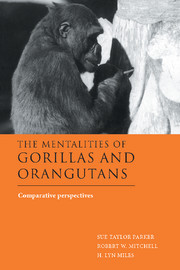Book contents
- Frontmatter
- Contents
- List of contributors
- Preface
- Acknowledgments
- I Comparative evolutionary and developmental perspectives on gorillas and orangutans
- 1 Hominid family values: morphological and molecular data on relations among the great apes and humans
- 2 The life history and development of great apes in comparative perspective
- 3 The frontal lobes of the great apes with a focus on the gorilla and the orangutan
- II Cognition and tool use in gorillas and orangutans
- III Communication in gorillas and orangutans
- IV Social cognition in gorillas and orangutans
- V Epilogue
- Index of authors
- Index of subjects
3 - The frontal lobes of the great apes with a focus on the gorilla and the orangutan
Published online by Cambridge University Press: 20 October 2009
- Frontmatter
- Contents
- List of contributors
- Preface
- Acknowledgments
- I Comparative evolutionary and developmental perspectives on gorillas and orangutans
- 1 Hominid family values: morphological and molecular data on relations among the great apes and humans
- 2 The life history and development of great apes in comparative perspective
- 3 The frontal lobes of the great apes with a focus on the gorilla and the orangutan
- II Cognition and tool use in gorillas and orangutans
- III Communication in gorillas and orangutans
- IV Social cognition in gorillas and orangutans
- V Epilogue
- Index of authors
- Index of subjects
Summary
INTRODUCTION
Major developments have taken place in the field of neuroscience during the last two decades. We have seen an explosion in imaging techniques used in the study of the structure and function of the living human brain, a variety of improved staining and immunohistological techniques used in post-mortem material, different tracing methods, and stereological and quantitative tools among others. Most of these innovative techniques, however, have not yet been incorporated in the comparative study of the primate brain nor in questions concerned with the evolution of the human brain.
There is a large body of knowledge about the brains of several monkey species and in particular about that of the macaque, as well as steadily growing information about the human brain. Nevertheless, very little is known about the brains of the apes and in particular the brains of gorillas and orangutans. The statement made by Tuttle (1986), more than ten years ago is still very much correct:
are there specific areas of ape central nervous systems (CNS) that underpin these capabilities and are they homologous with areas in the human CNS which are thought to make speech and other symbolically mediated behaviors possible? We are greatly hampered in the exploration of these questions by the fact that, to some extent, the “ape condition” must be interpolated from experiments on monkeys and clinical observations on humans.
(p. 175)- Type
- Chapter
- Information
- The Mentalities of Gorillas and OrangutansComparative Perspectives, pp. 70 - 96Publisher: Cambridge University PressPrint publication year: 1999
- 4
- Cited by



